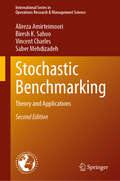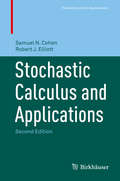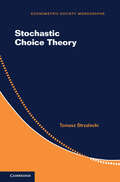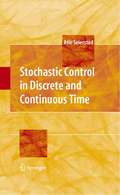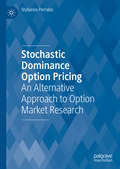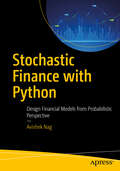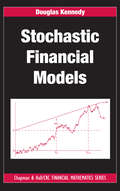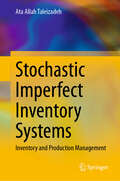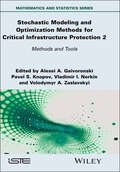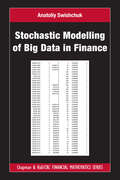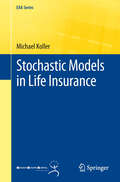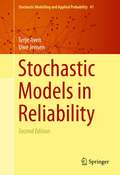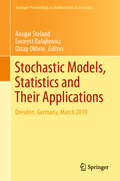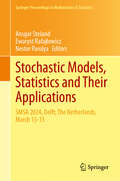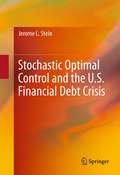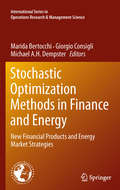- Table View
- List View
Stochastic Benchmarking: Theory and Applications (International Series in Operations Research & Management Science #317)
by Vincent Charles Alireza Amirteimoori Biresh K. Sahoo Saber MehdizadehThis book introduces readers to benchmarking techniques in the stochastic environment, primarily stochastic data envelopment analysis (DEA), and provides stochastic models in DEA for the possibility of variations in inputs and outputs. It focuses on the application of theories and interpretations of the mathematical programs, which are combined with economic and organizational thinking. The book’s main purpose is to shed light on the advantages of the different methods in deterministic and stochastic environments and thoroughly prepare readers to properly use these methods in various cases. Simple examples, along with graphical illustrations and real-world applications in industry, are provided for a better understanding. The models introduced here can be easily used in both theoretical and real-world evaluations. This book is intended for graduate and PhD students, advanced consultants, and practitioners with an interest in quantitative performance evaluation.
Stochastic Benchmarking: Theory and Applications (International Series in Operations Research & Management Science #371)
by Vincent Charles Alireza Amirteimoori Biresh K. Sahoo Saber MehdizadehThis book introduces readers to benchmarking techniques in the stochastic environment, primarily stochastic data envelopment analysis (DEA), and provides stochastic models in DEA for the possibility of variations in inputs and outputs. It focuses on the application of theories and interpretations of the mathematical programs, which are combined with economic and organizational thinking. The book&’s main purpose is to shed light on the advantages of the different methods in deterministic and stochastic environments and thoroughly prepare readers to properly use these methods in various cases. Simple examples, along with graphical illustrations and real-world applications in industry, are provided for a better understanding. The models introduced here can be easily used in both theoretical and real-world evaluations. This revised edition introduces three key updates: A new section on "Stochastic Data Envelopment Analysis in the Presence of Undesirable Outputs," extending Shephard's (1970) weak disposability assumption to a stochastic environment. A section on "Stochastic Scale Elasticity in the Presence of Undesirable Outputs" with an application to the power sector, incorporating both undesirable outputs and data uncertainty. Additionally, a new chapter on "Managerial Ability in Deterministic and Stochastic Environments" presents a two-step procedure using data envelopment analysis and regression analysis to assess managerial ability in the presence of multiple variables. This book is intended for graduate and PhD students, advanced consultants, and practitioners with an interest in quantitative performance evaluation.
Stochastic Calculus and Applications
by Robert J. Elliott Samuel N. CohenCompletely revised and greatly expanded, the new edition of this text takes readers who have been exposed to only basic courses in analysis through the modern general theory of random processes and stochastic integrals as used by systems theorists, electronic engineers and, more recently, those working in quantitative and mathematical finance. Building upon the original release of this title, this text will be of great interest to research mathematicians and graduate students working in those fields, as well as quants in the finance industry. New features of this edition include: End of chapter exercises; New chapters on basic measure theory and Backward SDEs; Reworked proofs, examples and explanatory material; Increased focus on motivating the mathematics; Extensive topical index. "Such a self-contained and complete exposition of stochastic calculus and applications fills an existing gap in the literature. The book can be recommended for first-year graduate studies. It will be useful for all who intend to work with stochastic calculus as well as with its applications. "-Zentralblatt (from review of the First Edition)
Stochastic Calculus and Differential Equations for Physics and Finance
by Joseph L. MccauleyStochastic calculus provides a powerful description of a specific class of stochastic processes in physics and finance. However, many econophysicists struggle to understand it. This book presents the subject simply and systematically, giving graduate students and practitioners a better understanding and enabling them to apply the methods in practice. The book develops Ito calculus and Fokker-Planck equations as parallel approaches to stochastic processes, using those methods in a unified way. The focus is on nonstationary processes, and statistical ensembles are emphasized in time series analysis. Stochastic calculus is developed using general martingales. Scaling and fat tails are presented via diffusive models. Fractional Brownian motion is thoroughly analyzed and contrasted with Ito processes. The Chapman-Kolmogorov and Fokker-Planck equations are shown in theory and by example to be more general than a Markov process. The book also presents new ideas in financial economics and a critical survey of econometrics.
Stochastic Calculus for Finance
by Janusz Traple Ekkehard Kopp Marek CapinskiThis book focuses specifically on the key results in stochastic processes that have become essential for finance practitioners to understand. The authors study the Wiener process and Itô integrals in some detail, with a focus on results needed for the Black-Scholes option pricing model. After developing the required martingale properties of this process, the construction of the integral and the Itô formula (proved in detail) become the centrepiece, both for theory and applications, and to provide concrete examples of stochastic differential equations used in finance. Finally, proofs of the existence, uniqueness and the Markov property of solutions of (general) stochastic equations complete the book. Using careful exposition and detailed proofs, this book is a far more accessible introduction to Itô calculus than most texts. Students, practitioners and researchers will benefit from its rigorous, but unfussy, approach to technical issues. Solutions to the exercises are available online.
Stochastic Choice Theory (Econometric Society Monographs)
by Tomasz StrzaleckiModels of stochastic choice are studied in decision theory, discrete choice econometrics, behavioral economics and psychology. Numerous experiments show that perception of stimuli is not deterministic, but stochastic (randomly determined). A growing body of evidence indicates that the same is true of economic choices. Whether trials are separated by days or minutes, the fraction of choice reversals is substantial. Stochastic Choice Theory offers a systematic introduction to these models, unifying insights from various fields. It explores mathematical models of stochastic choice, which have a variety of applications in game theory, industrial organization, labor economics, marketing, and experimental economics. Offering a systematic introduction to the field, this book builds up from scratch without any prior knowledge requirements and surveys recent developments, bringing readers to the frontier of research.
Stochastic Control in Discrete and Continuous Time
by Atle SeierstadThis book provides a comprehensive introduction to stochastic control problems in discrete and continuous time. The material is presented logically, beginning with the discrete-time case using few mathematical tools before proceeding to the stochastic continuous-time models requiring more advanced mathematics. Topics covered include stochastic maximum principles for discrete time, continuous time, and for problems with terminal conditions. A nonstandard treatment of piecewise deterministic problems, related to some control problems, is also presented. Numerous illustrative examples and exercises are included to enhance the understanding of the reader. By interlinking many fields in stochastic control, the material gives the student the opportunity to see the connections between different fields and the underlying ideas that unify them. This text will be of benefit to students in economics, engineering, applied mathematics and related fields. Prerequisites include a course in calculus and elementary probability theory.
Stochastic Discounted Cash Flow: A Theory of the Valuation of Firms (Springer Texts in Business and Economics)
by Andreas Löffler Lutz KruschwitzThis open access book discusses firm valuation, which is of interest to economists, particularly those working in finance. Firm valuation comes down to the calculation of the discounted cash flow, often only referred to by its abbreviation, DCF. There are, however, different coexistent versions, which seem to compete against each other, such as entity approaches and equity approaches. Acronyms are often used, such as APV (adjusted present value) or WACC (weighted average cost of capital), two concepts classified as entity approaches.This book explains why there are several procedures and whether they lead to the same result. It also examines the economic differences between the methods and indicates the various purposes they serve. Further it describes the limits of the procedures and the situations they are best applied to. The problems this book addresses are relevant to theoreticians and practitioners alike.
Stochastic Dominance
by Haim LevyThis fully updated third edition is devoted to the analysis of various Stochastic Dominance (SD) decision rules. It discusses the pros and cons of each of the alternate SD rules, the application of these rules to various research areas like statistics, agriculture, medicine, measuring income inequality and the poverty level in various countries, and of course, to investment decision-making under uncertainty. The book features changes and additions to the various chapters, and also includes two completely new chapters. One deals with asymptotic SD and the relation between FSD and the maximum geometric mean (MGM) rule (or the maximum growth portfolio). The other new chapter discusses bivariate SD rules where the individual's utility is determined not only by his own wealth, but also by his standing relative to his peer group. Stochastic Dominance: Investment Decision Making under Uncertainty, 3rd Ed. covers the following basic issues: the SD approach, asymptotic SD rules, the mean-variance (MV) approach, as well as the non-expected utility approach. The non-expected utility approach focuses on Regret Theory (RT) and mainly on prospect theory (PT) and its modified version, cumulative prospect theory (CPT) which assumes S-shape preferences. In addition to these issues the book suggests a new stochastic dominance rule called the Markowitz stochastic dominance (MSD) rule corresponding to all reverse-S-shape preferences. It also discusses the concept of the multivariate expected utility and analyzed in more detail the bivariate expected utility case. From the reviews of the second edition: "This book is an economics book about stochastic dominance. . . . is certainly a valuable reference for graduate students interested in decision making under uncertainty. It investigates and compares different approaches and presents many examples. Moreover, empirical studies and experimental results play an important role in this book, which makes it interesting to read. " (Nicole Bäuerle, Mathematical Reviews, Issue 2007 d)
Stochastic Dominance Option Pricing: An Alternative Approach to Option Market Research
by Stylianos PerrakisThis book illustrates the application of the economic concept of stochastic dominance to option markets and presents an alternative option pricing paradigm to the prevailing no arbitrage simultaneous equilibrium in the frictionless underlying and option markets. This new methodology was developed primarily by the author, working independently or jointly with other co-authors, over the course of more than thirty years. Among others, it yields the fundamental Black-Scholes-Merton option value when markets are complete, presents a new approach to the pricing of rare event risk, and uncovers option mispricing that leads to tradeable strategies in the presence of transaction costs. In the latter case it shows how a utility-maximizing investor trading in the market and a riskless bond, subject to proportional transaction costs, can increase his/her expected utility by overlaying a zero-net-cost portfolio of options bought at their ask price and written at their bid price, irrespective of the specific form of the utility function. The book contains a unified presentation of these methods and results, making it a highly readable supplement for educators and sophisticated professionals working in the popular field of option pricing. It also features a foreword by George Constantinides, the Leo Melamed Professor of Finance at the Booth School of Business, University of Chicago, USA, who was a co-author in several parts of the book.
Stochastic Dominance and Applications to Finance, Risk and Economics
by Songsak Sriboonchita Wing-Keung Wong Sompong Dhompongsa Hung T. NguyenDrawing from many sources in the literature, Stochastic Dominance and Applications to Finance, Risk and Economics illustrates how stochastic dominance (SD) can be used as a method for risk assessment in decision making. It provides basic background on SD for various areas of applications. Useful Concepts and Techniques for Economics ApplicationsThe
Stochastic Finance with Python: Design Financial Models from Probabilistic Perspective
by Avishek NagJourney through the world of stochastic finance from learning theory, underlying models, and derivations of financial models (stocks, options, portfolios) to the almost production-ready Python components under cover of stochastic finance. This book will show you the techniques to estimate potential financial outcomes using stochastic processes implemented with Python. The book starts by reviewing financial concepts, such as analyzing different asset types like stocks, options, and portfolios. It then delves into the crux of stochastic finance, providing a glimpse into the probabilistic nature of financial markets. You’ll look closely at probability theory, random variables, Monte Carlo simulation, and stochastic processes to cover the prerequisites from the applied perspective. Then explore random walks and Brownian motion, essential in understanding financial market dynamics. You’ll get a glimpse of two vital modelling tools used throughout the book - stochastic calculus and stochastic differential equations (SDE). Advanced topics like modeling jump processes and estimating their parameters by Fourier-transform-based density recovery methods can be intriguing to those interested in full-numerical solutions of probability models. Moving forward, the book covers options, including the famous Black-Scholes model, dissecting it from both risk-neutral probability and PDE perspectives. A chapter at the end also covers the discovery of portfolio theory, beginning with mean-variance analysis and advancing to portfolio simulation and the efficient frontier. What You Will Learn Understand applied probability and statistics with finance Design forecasting models of the stock price with the stochastic process, Monte-Carlo simulation. Option price estimation with both risk-neutral probabilistic and PDE-driven approach. Use Object-oriented Python to design financial models with reusability. Who This Book Is For Data scientists, quantitative researchers and practitioners, software engineers and AI architects interested in quantitative finance
Stochastic Financial Models (Chapman and Hall/CRC Financial Mathematics Series)
by Douglas KennedyFilling the void between surveys of the field with relatively light mathematical content and books with a rigorous, formal approach to stochastic integration and probabilistic ideas, Stochastic Financial Models provides a sound introduction to mathematical finance. The author takes a classical applied mathematical approach, focusing on calculations
Stochastic Imperfect Inventory Systems: Inventory and Production Management
by Ata Allah TaleizadehIn today’s manufacturing environment, managing inventories is one of the basic concerns of enterprises dealing with materials according to their activities. This book introduces and examines important production strategies such as scrap strategy and rework strategy under stochastic conditions that contribute to the reduction of unexpected costs. In a step-by-step manner, it presents stochastic imperfect inventory models, inventory models involving rework processes or breakdowns, as well as their maintenance. Also, different aspects of uncertainty are provided in multiple chapters of this book.One of the primary questions answered in this book is: What is the optimal production quantity when there is a failure in the production line? To answer the question, the problem is first modelled mathematically, then the concavity or convexity of the objective function is proved and finally the optimal production quantity of the production system is determined using suitable solution methods. The book is valuable for researchers in operations research and inventory management and professionals working with supply chains.
Stochastic Modeling and Optimization Methods for Critical Infrastructure Protection, Volume 2: Methods and Tools (ISTE Invoiced)
by Pavel S. Knopov Alexei A. Gaivoronski Volodymyr A. Zaslavskyi Vladimir I. NorkinStochastic Modeling and Optimization Methods for Critical Infrastructure Protection is a thorough exploration of mathematical models and tools that are designed to strengthen critical infrastructures against threats – both natural and adversarial. Divided into two volumes, this first volume examines stochastic modeling across key economic sectors and their interconnections, while the second volume focuses on advanced mathematical methods for enhancing infrastructure protection. The book covers a range of themes, including risk assessment techniques that account for systemic interdependencies within modern technospheres, the dynamics of uncertainty, instability and system vulnerabilities. The book also presents other topics such as cryptographic information protection and Shannon’s theory of secret systems, alongside solutions arising from optimization, game theory and machine learning approaches. Featuring research from international collaborations, this book covers both theory and applications, offering vital insights for advanced risk management curricula. It is intended not only for researchers, but also educators and professionals in infrastructure protection and stochastic optimization.
Stochastic Modeling and Optimization Methods for Critical Infrastructure Protection, Volume 2: Methods and Tools (ISTE Invoiced)
by Pavel S. Knopov Alexei A. Gaivoronski Volodymyr A. Zaslavskyi Vladimir I. NorkinStochastic Modeling and Optimization Methods for Critical Infrastructure Protection is a thorough exploration of mathematical models and tools that are designed to strengthen critical infrastructures against threats – both natural and adversarial. Divided into two volumes, this first volume examines stochastic modeling across key economic sectors and their interconnections, while the second volume focuses on advanced mathematical methods for enhancing infrastructure protection. The book covers a range of themes, including risk assessment techniques that account for systemic interdependencies within modern technospheres, the dynamics of uncertainty, instability and system vulnerabilities. The book also presents other topics such as cryptographic information protection and Shannon’s theory of secret systems, alongside solutions arising from optimization, game theory and machine learning approaches. Featuring research from international collaborations, this book covers both theory and applications, offering vital insights for advanced risk management curricula. It is intended not only for researchers, but also educators and professionals in infrastructure protection and stochastic optimization.
Stochastic Modelling of Big Data in Finance (Chapman and Hall/CRC Financial Mathematics Series)
by Anatoliy SwishchukStochastic Modelling of Big Data in Finance provides a rigorous overview and exploration of sto- chastic modelling of big data in finance (BDF). The book describes various stochastic models, including multivariate models, to deal with big data in finance. This includes data in high-frequency and algorithmic trading, specifically in limit order books (LOB), and shows how those models can be applied to different datasets to describe the dynamics of LOB, and to figure out which model is the best with respect to a specific data set. The results of the book may be used to also solve acquisition, liquidation and market making problems, and other optimization problems in finance.Features• Self-contained book suitable for graduate students and post-doctoral fellows in financial math- ematics and data science, as well as for practitioners working in the financial industry who deal with big data• All results are presented visually to aid in understanding of concepts Dr. Anatoliy Swishchuk is a Professor in Mathematical Finance at the Department of Mathematics and Statistics, University of Calgary, Calgary, AB, Canada. He got his B.Sc. and M.Sc. degrees from Kyiv State University, Kyiv, Ukraine. He earned two doctorate degrees in Mathematics and Physics (PhD and DSc) from the prestigious National Academy of Sciences of Ukraine (NASU), Kiev, Ukraine, and is a recipient of NASU award for young scientist with a gold medal for series of research publica- tions in random evolutions and their applications.Dr. Swishchuk is a chair and organizer of finance and energy finance seminar ‘Lunch at the Lab’ at the Department of Mathematics and Statistics. Dr. Swishchuk is a Director of Mathematical and Compu- tational Finance Laboratory at the University of Calgary. He was a steering committee member of the Professional Risk Managers International Association (PRMIA), Canada (2006-2015), and is a steer- ing committee member of Global Association of Risk Professionals (GARP), Canada (since 2015).Dr. Swishchuk is a creator of mathematical finance program at the Department of Mathematics & Sta- tistics. He is also a proponent for a new specialization “Financial and Energy Markets Data Modelling” in the Data Science and Analytics program. His research areas include financial mathematics, ran- dom evolutions and their applications, biomathematics, stochastic calculus, and he serves on editorial boards for four research journals. He is the author of more than 200 publications, including 15 books and more than 150 articles in peer-reviewed journals. In 2018 he received a Peak Scholar award.
Stochastic Models for Prices Dynamics in Energy and Commodity Markets: An Infinite-Dimensional Perspective (Springer Finance)
by Fred Espen Benth Paul KrühnerThis monograph presents a theory for random field models in time and space, viewed as stochastic processes with values in a Hilbert space, to model the stochastic dynamics of forward and futures prices in energy, power, and commodity markets. In this book, the well-known Heath–Jarrow–Morton approach from interest rate theory is adopted and extended into an infinite-dimensional framework, allowing for flexible modeling of price stochasticity across time and along the term structure curve. Various models are introduced based on stochastic partial differential equations with infinite-dimensional Lévy processes as noise drivers, emphasizing random fields described by low-dimensional parametric covariance functions instead of classical high-dimensional factor models. The Filipović space, a separable Hilbert space of Sobolev type, is found to be a convenient state space for the dynamics of forward and futures term structures. The monograph provides a classification of important operators in this space, covering covariance operators and the stochastic modeling of volatility term structures, including the Samuelson effect. Fourier methods are employed to price many derivatives of interest in energy, power, and commodity markets, and sensitivity 'delta' expressions can be derived. Additionally, the monograph covers forward curve smoothing, the connection between forwards with fixed delivery and delivery period, as well as the classical theory of forward and futures pricing. This monograph will appeal to researchers and graduate students interested in mathematical finance and stochastic analysis applied in the challenging markets of energy, power, and commodities. Practitioners seeking sophisticated yet flexible and analytically tractable risk models will also find it valuable.
Stochastic Models for Time Series (Mathématiques et Applications #80)
by Paul DoukhanThis book presents essential tools for modelling non-linear time series. The first part of the book describes the main standard tools of probability and statistics that directly apply to the time series context to obtain a wide range of modelling possibilities. Functional estimation and bootstrap are discussed, and stationarity is reviewed. The second part describes a number of tools from Gaussian chaos and proposes a tour of linear time series models. It goes on to address nonlinearity from polynomial or chaotic models for which explicit expansions are available, then turns to Markov and non-Markov linear models and discusses Bernoulli shifts time series models. Finally, the volume focuses on the limit theory, starting with the ergodic theorem, which is seen as the first step for statistics of time series. It defines the distributional range to obtain generic tools for limit theory under long or short-range dependences (LRD/SRD) and explains examples of LRD behaviours. More general techniques (central limit theorems) are described under SRD; mixing and weak dependence are also reviewed. In closing, it describes moment techniques together with their relations to cumulant sums as well as an application to kernel type estimation.The appendix reviews basic probability theory facts and discusses useful laws stemming from the Gaussian laws as well as the basic principles of probability, and is completed by R-scripts used for the figures. Richly illustrated with examples and simulations, the book is recommended for advanced master courses for mathematicians just entering the field of time series, and statisticians who want more mathematical insights into the background of non-linear time series.
Stochastic Models in Life Insurance
by Michael KollerThe book provides a sound mathematical base for life insurance mathematics and applies the underlying concepts to concrete examples. Moreover the models presented make it possible to model life insurance policies by means of Markov chains. Two chapters covering ALM and abstract valuation concepts on the background of Solvency II complete this volume. Numerous examples and a parallel treatment of discrete and continuous approaches help the reader to implement the theory directly in practice.
Stochastic Models in Reliability
by Terje Aven Uwe JensenThis book provides a comprehensive up-to-date presentation of some of the classical areas of reliability, based on a more advanced probabilistic framework using the modern theory of stochastic processes. This framework allows analysts to formulate general failure models, establish formulae for computing various performance measures, as well as determine how to identify optimal replacement policies in complex situations. In this second edition of the book, two major topics have been added to the original version: copula models which are used to study the effect of structural dependencies on the system reliability; and maintenance optimization which highlights delay time models under safety constraints. Terje Aven is Professor of Reliability and Risk Analysis at University of Stavanger, Norway. Uwe Jensen is working as a Professor at the Institute of Applied Mathematics and Statistics of the University of Hohenheim in Stuttgart, Germany. Review of first edition: "This is an excellent book on mathematical, statistical and stochastic models in reliability. The authors have done an excellent job of unifying some of the stochastic models in reliability. The book is a good reference book but may not be suitable as a textbook for students in professional fields such as engineering. This book may be used for graduate level seminar courses for students who have had at least the first course in stochastic processes and some knowledge of reliability mathematics. It should be a good reference book for researchers in reliability mathematics." --Mathematical Reviews (2000)
Stochastic Models, Statistics and Their Applications: Dresden, Germany, March 2019 (Springer Proceedings in Mathematics & Statistics #294)
by Ansgar Steland Ewaryst Rafajłowicz Ostap OkhrinThis volume presents selected and peer-reviewed contributions from the 14th Workshop on Stochastic Models, Statistics and Their Applications, held in Dresden, Germany, on March 6-8, 2019. Addressing the needs of theoretical and applied researchers alike, the contributions provide an overview of the latest advances and trends in the areas of mathematical statistics and applied probability, and their applications to high-dimensional statistics, econometrics and time series analysis, statistics for stochastic processes, statistical machine learning, big data and data science, random matrix theory, quality control, change-point analysis and detection, finance, copulas, survival analysis and reliability, sequential experiments, empirical processes, and microsimulations. As the book demonstrates, stochastic models and related statistical procedures and algorithms are essential to more comprehensively understanding and solving present-day problems arising in e.g. the natural sciences, machine learning, data science, engineering, image analysis, genetics, econometrics and finance.
Stochastic Models, Statistics and Their Applications: SMSA 2024, Delft, The Netherlands, March 13-15 (Springer Proceedings in Mathematics & Statistics #499)
by Ansgar Steland Ewaryst Rafajłowicz Nestor ParolyaThis volume presents contemporary research in stochastic modeling, statistical inference and their applications, and collects peer-reviewed contributions presented at the 15th Workshop on Stochastic Models, Statistics and Their Applications, SMSA 2024, held in Delft, The Netherlands, March 13-15, 2024. It brings together a unique mix of authors, working on theoretical and applied problems, and addresses a wide variety of topics from the workshop&’s focus areas, which included Bayesian methods, change point analysis, computational statistics, econometrics, high-dimensional, nonparametric and spatial statistics, statistical process monitoring, statistics for stochastic processes, and sequential and time series analysis. The volume is structured in three parts, covering stochastics and statistical theory, statistical inference and machine learning, and testing for patterns in data. The contributions discuss highly active research topics, such as strong approximation in high dimensions, modeling and testing multivariate distributions, the interplay and fusion of statistical ideas and machine learning, approaches to handling discrete and ordinal data, and detection of hidden patterns in data, with applications to environmental science, business and engineering.
Stochastic Optimal Control and the U.S. Financial Debt Crisis
by Jerome L. SteinStochastic Optimal Control (SOC)--a mathematical theory concerned with minimizing a cost (or maximizing a payout) pertaining to a controlled dynamic process under uncertainty--has proven incredibly helpful to understanding and predicting debt crises and evaluating proposed financial regulation and risk management. Stochastic Optimal Control and the U.S. Financial Debt Crisis analyzes SOC in relation to the 2008 U.S. financial crisis, and offers a detailed framework depicting why such a methodology is best suited for reducing financial risk and addressing key regulatory issues. Topics discussed include the inadequacies of the current approaches underlying financial regulations, the use of SOC to explain debt crises and superiority over existing approaches to regulation, and the domestic and international applications of SOC to financial crises. Principles in this book will appeal to economists, mathematicians, and researchers interested in the U.S. financial debt crisis and optimal risk management.
Stochastic Optimization Methods in Finance and Energy
by Michael A. Dempster Giorgio Consigli Marida BertocchiThis volume presents a collection of contributions dedicated to applied problems in the financial and energy sectors that have been formulated and solved in a stochastic optimization framework. The invited authors represent a group of scientists and practitioners, who cooperated in recent years to facilitate the growing penetration of stochastic programming techniques in real-world applications, inducing a significant advance over a large spectrum of complex decision problems. After the recent widespread liberalization of the energy sector in Europe and the unprecedented growth of energy prices in international commodity markets, we have witnessed a significant convergence of strategic decision problems in the energy and financial sectors. This has often resulted in common open issues and has induced a remarkable effort by the industrial and scientific communities to facilitate the adoption of advanced analytical and decision tools. The main concerns of the financial community over the last decade have suddenly penetrated the energy sector inducing a remarkable scientific and practical effort to address previously unforeseeable management problems. Stochastic Optimization Methods in Finance and Energy: New Financial Products and Energy Markets Strategies aims to include in a unified framework for the first time an extensive set of contributions related to real-world applied problems in finance and energy, leading to a common methodological approach and in many cases having similar underlying economic and financial implications. Part 1 of the book presents 6 chapters related to financial applications; Part 2 presents 7 chapters on energy applications; and Part 3 presents 5 chapters devoted to specific theoretical and computational issues.

